

Color, 2009, 92m.
Directed by Kurando Mitsutake
Starring Kurando Mitsutake, Jeffrey James Lippold, Domiziano Arcangeli, Megan Hallin, Mariko Denda, Tegan Ashton Cohan
Synapse ( Blu-ray) (US R0 HD), Maya (DVD) (US R1 NTSC), WVG (Blu-ray & DVD) (Germany R0 HD/PAL), SND (Blu-ray & DVD) (France R0 HD/PAL), Ascot Elite (Blu-ray & DVD) (Austria R0 HD/PAL) / WS (2.35:1) (16:9)
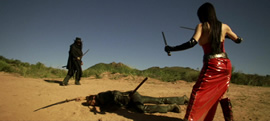 This well-intentioned genre mash up was a labor of love for director-writer-producer-star Kurando Mitsutake, a Japanese-born film student
This well-intentioned genre mash up was a labor of love for director-writer-producer-star Kurando Mitsutake, a Japanese-born film student 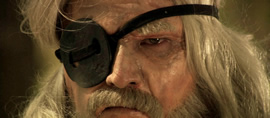 who expanded this from a promotional short and went on to helm the violent crime film Gun Woman. How much you like it will depend on your tolerance for the whole nouveaux grindhouse approach, with fake distressed film effects popping up during the most violent moments and whole scenes lifted from the Zatoichi and Lone Wolf and Cub series.
who expanded this from a promotional short and went on to helm the violent crime film Gun Woman. How much you like it will depend on your tolerance for the whole nouveaux grindhouse approach, with fake distressed film effects popping up during the most violent moments and whole scenes lifted from the Zatoichi and Lone Wolf and Cub series.
A sightless samurai known as the Blind Wolf (Mitsutake) is wandering the dusty wilds of an unnamed land (that looks a lot like Southern California) and killing off people who try to ambush him, such as the seemingly harmless guy who gives him a lift in the opening scene. As it turns out, Blind Wolf, a former nice family man, is on a quest for vengeance after a very bad man named Nathan (Arcangeli) raped and murdered his wife (after biting off her ear), shooting his daughter, and forcing him to blind himself with a twig. Joining Blind Wolf on his journey is another man on a mission, Drifter (Lippold), and together they face off against foes like the Hypnotist (Denda), a scene-stealing 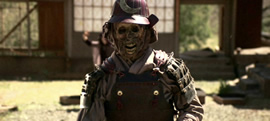 topless warrior, and Zombie Mistress (Cohan), a pregnant queen of the supernatural who enters dragging three coffins a la Django that house a trio of zombie swordsmen.
topless warrior, and Zombie Mistress (Cohan), a pregnant queen of the supernatural who enters dragging three coffins a la Django that house a trio of zombie swordsmen.
On the positive side, Mitsutake has a lot of affection for samurai films and  stages some fun variations on familiar scenarios, particularly a third act harakiri twist that turns out to be the best moment in the entire film. A few of the other genre injections work well, such as that zombie bit and some well-placed practical gore effects that drench the screen in blood. Unfortunately the decision to go fake "grindhouse" results in a lot of questionable decisions as well; the aesthetic is the polar opposite of how classic samurai films were made, so it's really just jarring when the film starts to get jumpy and scratchy or cuts away to strippers in neon bikinis gyrating over the opening credits. The rape/murder flashback is also highly problematic as it becomes so vicious and tonally out of whack with the rest of the film that it never feels transgressive or shocking; instead you just feel really sorry for the poor actress getting stripped naked, smacked around, verbally abused, and finished off with a tacky CGI head shot. The spaghetti western score never really gels either, and the actors always seem to be struggling with the half-baked script and recycled dialogue. That said, Mitsutake
stages some fun variations on familiar scenarios, particularly a third act harakiri twist that turns out to be the best moment in the entire film. A few of the other genre injections work well, such as that zombie bit and some well-placed practical gore effects that drench the screen in blood. Unfortunately the decision to go fake "grindhouse" results in a lot of questionable decisions as well; the aesthetic is the polar opposite of how classic samurai films were made, so it's really just jarring when the film starts to get jumpy and scratchy or cuts away to strippers in neon bikinis gyrating over the opening credits. The rape/murder flashback is also highly problematic as it becomes so vicious and tonally out of whack with the rest of the film that it never feels transgressive or shocking; instead you just feel really sorry for the poor actress getting stripped naked, smacked around, verbally abused, and finished off with a tacky CGI head shot. The spaghetti western score never really gels either, and the actors always seem to be struggling with the half-baked script and recycled dialogue. That said, Mitsutake 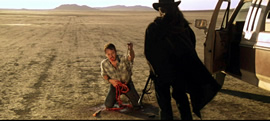 manages to make for a reasonably compelling hero (with very little chit chat), and Lippold, who could be a great action actor with stronger material, somehow manages to be charismatic and sympathetic even when he gets some of the weakest lines.
manages to make for a reasonably compelling hero (with very little chit chat), and Lippold, who could be a great action actor with stronger material, somehow manages to be charismatic and sympathetic even when he gets some of the weakest lines.
Six years after its completion and a handful of European Blu-ray releases (and a DVD-only American one), Samurai Avenger: The Blind Wolf comes to Blu-ray from Synapse with a sterling presentation up to their usual high standards. The digitally-shot film basks in unnatural colors, including some eye-popping shades of gold and red, and it looks very clean and detailed here except when the image degrades on purpose. 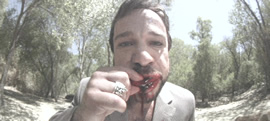 The DTS-HD MA 5.1 track does a solid job of rendering the film's loud, Morricone and surf rock-inspired soundtrack. The main extra here is an 89-minute documentary about the making of the film with pretty much every single person involved interviewed (with bad in-camera microphones) interspersed with behind-the-scenes footage and some clips from his earlier short films. The sword training bits are the most interesting, and the special effects are covered with some nifty demonstrations of how the elaborate latex effects were applied. There's also a fun look at shooting of a cameo by a certain Pulp Fiction alumnus, too. The sword fight choreography is also covered in a 12-minute featurette with Peter Steeves demonstrating training moves for the actors. Also included are a production stills gallery, a slideshow of character design and storyboard concepts, a storyboard-to-scene comparison, a 10-minute blooper reel, and a theatrical trailer. Also included for the main feature is an audio commentary with Mitsutake, producer Chiaki Yanagimoto, and editor John Migdal who run through the often amusing production challenges of mounting the fight scenes and discuss everything from the various California locales to doing in-camera slow motion and all the little homages to Japanese cinema scattered throughout the fight scenes.
The DTS-HD MA 5.1 track does a solid job of rendering the film's loud, Morricone and surf rock-inspired soundtrack. The main extra here is an 89-minute documentary about the making of the film with pretty much every single person involved interviewed (with bad in-camera microphones) interspersed with behind-the-scenes footage and some clips from his earlier short films. The sword training bits are the most interesting, and the special effects are covered with some nifty demonstrations of how the elaborate latex effects were applied. There's also a fun look at shooting of a cameo by a certain Pulp Fiction alumnus, too. The sword fight choreography is also covered in a 12-minute featurette with Peter Steeves demonstrating training moves for the actors. Also included are a production stills gallery, a slideshow of character design and storyboard concepts, a storyboard-to-scene comparison, a 10-minute blooper reel, and a theatrical trailer. Also included for the main feature is an audio commentary with Mitsutake, producer Chiaki Yanagimoto, and editor John Migdal who run through the often amusing production challenges of mounting the fight scenes and discuss everything from the various California locales to doing in-camera slow motion and all the little homages to Japanese cinema scattered throughout the fight scenes.
Reviewed on May 17, 2015.








